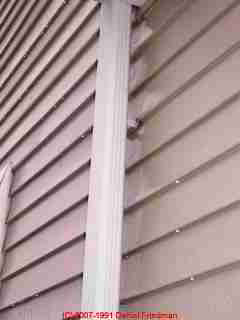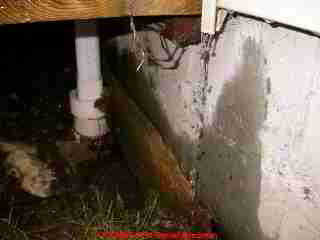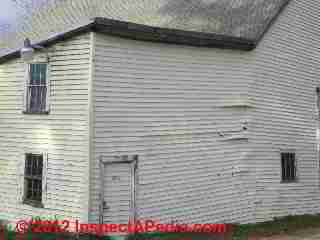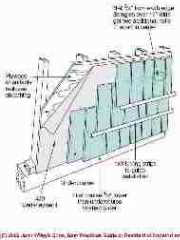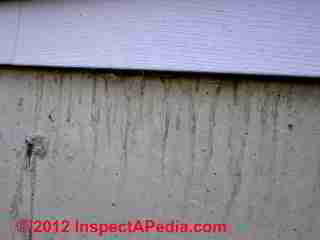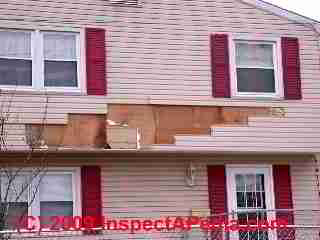 Need For & Role of Moisture Barriers Beneath Vinyl & Other Building Siding
Need For & Role of Moisture Barriers Beneath Vinyl & Other Building Siding
- POST a QUESTION or COMMENT about moisture & vapor barrier requirements underneath building wall siding
Vinyl siding & other applications & requirements for house wrap:
The requirement for water or rain barrier on building walls: this article discusses of the need for external vapor barriers beneath vinyl, siding - building code requirements, interpretation, and home inspection concerns.
Discussed here: Leaks into vinyl-sided building. Select & Use House Wrap. Code Requirements for Building Wrap. Sheathing Wrap Performance Measures. Water Resistance of Housewraps. Air Infiltration of Housewraps. Performance Table for Housewraps.
Can the Vapor Barrier or better-termed, Moisture Barrier be Omitted? Guide to choosing & using synthetic, paper, felt, plastic & draining housewraps: house wrap requirements, Tyvek, Rwrap, Typar, building paper, roofing felt, rosin paper: the acceptability of various materials for use as house wrap or rain barrier under wall siding.
We include photographs and sketches of vinyl siding installation procedures and of common defects observed in vinyl exterior building siding, such as buckling, splitting, cracks, odors, and questions about the need for a vapor barrier behind vinyl siding and over building sheathing.
InspectAPedia tolerates no conflicts of interest. We have no relationship with advertisers, products, or services discussed at this website.
- Daniel Friedman, Publisher/Editor/Author - See WHO ARE WE?
Examples of Leaks into a Vinyl-sided Building Demonstrate Need for a Water Barrier on Building Exterior Walls
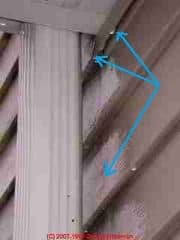
Our page top photo shows significant leak stains on and into a building exterior wall where wind has blown vinyl siding off of this 1960's townhouse in Bellmawr, New Jersey.
[Click to enlarge any image]
Our siding leak photo (left) shows a typical source of concentrated water running down, onto, and into vinyl siding on a 1990's home in Pawling, New York.
Article Contents
- HOUSEWRAP AIR & VAPOR BARRIERS
- LEAKS into VINYL SIDED BUILDINGS
- SELECT & USE HOUSE WRAP
- CODE REQUIREMENTS for BUILDING WRAP
- SHEATHING WRAP PERFORMANCE MEASURES
- WATER RESISTANCE of HOUSE WRAPS
- AIR INFILTRATION of HOUSEWRAPS
- PERFORMANCE TABLE of HOUSEWRAPS - permeance ratings or "perm" ratings of types of housewrap materials & plywood & OSB
- CAN the VAPOR BARRIER or HOUSEWRAP be OMITTED?
The purpose of building sheathing paper (such as Typar™, Tyvek™ or "Housewrap") is to prevent drafts and the entry of wind-driven rain into the wall cavity. Certain types of siding consisting of large sheets or panels will perform this function, eliminating the need for sheathing paper.
This requirement applies to siding such as that commonly used on mobile homes but does not apply to siding installed in strips which is intended to simulate the appearance of a lapped wood siding.
Such material does not act as a substitute for sheathing paper since it incorporates provision for venting the wall cavity and has many joints. This article includes excerpts or adaptations from Best Practices Guide to Residential Construction (see our BOOK REVIEW of that book), with additional code citations and explanation were provided by building experts Al Carson, Mark Cramer & Daniel Friedman.
- Daniel Friedman, Mark Cramer , Alan Carson
What's the Difference Between a Moisture Barrier (Housewrap) and a Vapor Barrier ?
First let's get something straight:
A moisture barrier is intended to keep actual water from passing through the barrier. Housewraps are moisture barriers, or water barriers, or rain barriers because they keep actual drops of water out of the building wall cavity, but they do not trap the much-smaller individual molecules of water H2O - water vapor.
Housewrap is a moisture barrier that also serves as an air-leak or wind barrier.
A vapor barrier is intended to keep water vapor or water molecules from passing through the barrier. Water vapor is a gas or "vapor".
Plastic or polyethylene is a vapor barrier. The plastic sometimes used on the warm-side of building walls (on the wall interior under drywall in northern climates) is a vapor barrier. Vapor barriers are both waterproof and vapor-proof.
Watch out: we do not want a vapor barrier on both sides of a building wall or top floor ceiling as that risks trapping moisture in the building cavity, leading to mold or rot. In a heating climate (northern or cooler climates) the vapor barrier goes on the warm side of the wall, usually the side closest to the building interior. In a cooling climate (hot southern climes) where air conditioning is used more than heating systems, the vapor barrier might go on the outside of the wall.
About these photographs of leaks on and perhaps into a vinyl-sided house wall
The page top photograph shows that a lot of water, more than you might guess, may be running over the surface of building exterior siding, vinyl, aluminum, wood, anything.
Many siding materials are not themselves a waterproof external building skin.
Where high volumes of water run down siding, leaks into the building windows or walls are possible, leading to costly hidden damage such as from rot, mold, or insects.
If we add the effects of wind pushing rain against a building these effects are increased still further.
The pair of photographs shown just above make clear that a lot of water was running on the exterior of this particular building, in this case due to an improper roof flashing and gutter design that combined a large volume of roof runoff falling into a gutter that leaks against the building.
At this unfortunate and new vinyl-sided home where workmanship was not the best, the leaky gutter and wet wall finally send water into a low area beneath a deck where water, trapped against the building wall, is likely to eventually find its way into the building basement.
As you can see from our horrible vinyl siding trouble at left (Portland, Maine), leaks may occur in vinyl siding for a wide range of reasons, including structural movement, bending, and breaking.
The building at above left asks more of the vinyl siding than the product can be expected to deliver.
Wet walls, wet basement, and hidden damage are the risks here. Installation of a water barrier behind this siding, combined with proper window and door flashing, would significantly reduce the risk of future building damage.
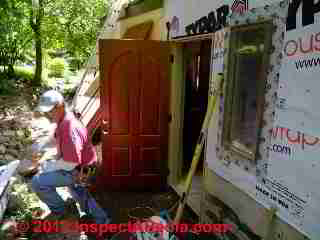
Shown in our photograph at above left, housewrap covered the building sheathing and framing around this first floor entry, and was lapped over the foundation wall for about twelve inches - more material was needed, lapped with its upper edge underneath the upper course of housewrap so that the finish siding could extend closer to the ground.
Guide to Selecting & Using Sheathing Wrap - House Wrap - Building Exterior Moisture Barriers
As described in Best Practices Guide to Residential Construction:
The primary goal of a sheathing wrap (or housewrap) is to protect a building’s structural components from water. At the same time, the sheathing wrap must be permeable enough to allow drying to the building’s exterior if the framing or sheathing should get wet.
While the permeance and water- resistance ratings of sheathing wraps vary significantly, how they are installed is far more important than the specific product used. The key is to always lap the sheathing wrap to shed water and to properly integrate the wrap with flashings so water is directed on top of the layer below.
All sheathing wraps fall into three basic types: asphalt felt, Grade D building paper, and synthetic housewrap. Grade D building paper is used primarily under stucco in the western United States and is essentially a lighter- weight version of asphalt felt.
Comparing one material to another is difficult since there is no single standard for all products, and even where manufacturers follow the same test standard, test conditions may vary dramatically from one company to the next.
Building Code Requirements for Building Sheathing Wrap
Our photo shows an example of Typar housewrap being applied during new construction. Continuing from from Best Practices Guide to Residential Construction (Steve Bliss, J Wiley & Sons) :
The 2003 International Building Code calls for a “waterresistive barrier behind the exterior veneer” consisting of flashings and a “weather-resistant sheathing paper” lapped at least 2 inches horizontally and 6 inches vertically.
It specifies asphalt-saturated felt that weighs at least 14 pounds per square and complies with ASTM D226, which means that most unrated No. 15 felt paper sold at lumberyards (which weigh closer to 7 pounds per square) do not comply.
Nearly all the plastic housewraps have been submitted to the model code authorities and accepted as substitutes for ASTM rated No. 15 building paper. If building in an area that follows the Model Energy Code (MEC), builders must either install a “vapor-permeable housewrap” on the exterior or seal all the penetrations in the building by using some combination of polyethylene, caulks, and gaskets on the interior.
Performance Measures for Building Sheathing Wrap
What is the definition of permeance? Permeance ratings measure the rate at which water vapor passes through a material. One perm equals one grain of water vapor passing through one square foot of material per hour per inch of vapor-pressure difference.
Under ASTM standard E96, manufacturers can use either test A (dry cup) or test B (wet cup), which yield somewhat different results. Grade D building paper uses yet another standard for measuring permeance, which is roughly equivalent to a permeance rating of about 5, similar to asphalt felt materials. Plastic housewraps range in permeance from around 5 to over 50.
In general, a sheathing wrap should have a permeance of at least 5 to enable wall assemblies to dry out should they get wet. Since common sheathing products like plywood and oriented-strand board (OSB) have permeance ratings of less than one, the sheathing is more likely to interfere with drying than the sheathing wrap.
Research note on housewrap tests: According to U. Mass building scientist Paul Fiske who conducted his own independent tests of the permeance of several housewrap products:
Tyvek, Rwrap and 15-pound felt showed no signs of liquid water leakage throughout the 2-day test period. However, the blotter paper on the Tyvek and Rwrap samples felt slightly damp to the touch by the end of the period, suggesting that there had been some transfer of water vapor by diffusion.
Blotter paper disks on the 15-pound felt paper samples remained bone dry to the touch.
Typar samples all leaked within the first 2-hours of the test. Two of the Typar samples leaked immediately – as soon as the blotter paper was placed onto the wrap. Blotter paper indicators for Barricade, Pink Wrap, and AmoWrap (all perforated wraps) became saturated before the layers of the test setups could be secured with an elastic band.
... Felt paper leaked after 30 minutes in the column test, but still makes my list as a strong candidate.
Fiske, who questions the viability of housewraps as weather barriers in general, prefers to rely on building flashing and good design [which in our opinion fails to address water penetration of building siding in the general field of the material during windy wet weather].
Fiske also likes felt paper better than plastic type housewraps because if water does penetrate behind it, the permeance of felt means that water can also escape.
Guide to Water Resistance of Building Sheathing Wraps, Building Papers, Housewraps
Vinyl Siding Stains & Brown Leak Stains on Foundation Walls Below Vinyl Siding
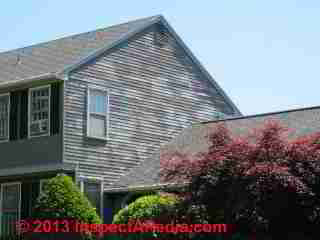
Many siding materials are not themselves a waterproof external building skin. Where high volumes of water run down siding, leaks into the building windows or walls are possible, leading to costly hidden damage such as from rot, mold, or insects.
If we add the effects of wind pushing rain against a building these effects are increased still further.
Check out these companion articles: VINYL SIDING INSTALLATION
and VINYL SIDING INSPECTION & REPAIR for illustrations of troubleshooting leaks, buckling, blowing off, loose or other vinyl siding troubles.
In the two photographs above and just below you can see stains on the building foundation wall below a vinyl-sided home - these stain patterns are a common source of questions about where leaks are occurring and what will be their effect on the building.
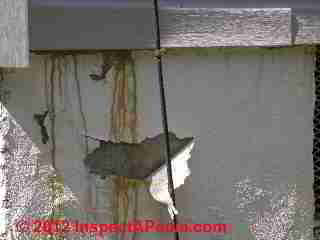
Brown leak stains appearing on the foundation wall below vinyl building siding may be traced to a single event (a plumbing leak for example) or to recurrent events (wind-blown rain), either of which can send water down the building wall behind the siding itself. A sheathing wrap can't do much to stop the effects of a plumbing leak into the building wall. That water is moving from inside the building out.
But if the sheathing wrap is properly installed it can stop or significantly reduce the movement of wind-blown rain through the siding and down the building sheathing.
Housewrap Permeability
Permeability of housewraps by water: Several different tests are used to measure the ability of building papers to stop liquid water. Grade D building papers must have a 10-minute rating under ASTM D779, commonly called the “boat test,” in which a piece of building paper is folded in the shape of a boat and floated in a dish of water until it soaks through and wets a powder on top. Some Grade D papers are rated as high as 60 minutes.
In general, products with very high vapor permeability, such as DuPont’s Tyvek®, do poorly in the boat test since water vapor can pass through and wet the indicator powder.
However, Tyvek® and other non perforated plastic housewraps perform well in the alternate “hydro-head” test in which the material is placed under a 22-inch column of water and must not leak for five hours. More importantly, non perforated plastic housewraps generally do a very good job of shedding liquid water in the field.
Guide to Air Infiltration Specifications of Building Sheathing Wraps, Building Papers, Housewraps
Air leak resistance of housewraps: Many sheathing wrap suppliers tout their products’ ability to block air infiltration, often citing proprietary test results. Some follow ASTM E283, in which an 8-foot-square wall section is tested before and after installation of the sheathing wrap.
However, since the manufacturer is free to specify the type of wall assembly, one test is not comparable to another, and none simulates real job-site conditions with seams and holes in the sheathing wrap.
If a house already has a reasonably tight wall assembly, there is little evidence that a layer of housewrap will significantly tighten the building. In general, air-sealing efforts are better spent on the building’s interior, using caulks and gaskets or a continuous polyethylene air/vapor barrier.
See MOISTURE PROBLEMS: CAUSE & CURE for additional detail about air and moisture movement through buildings.
Table of Performance Characteristics of Building Housewraps & Sheathing-Wrap Materials
Installed carefully, any of the sheathing wraps can perform well and keep water out of walls. The three main choices are traditional asphalt felt, Grade D building paper, and the newer plastic housewraps. The optimal product will depend upon the siding choice, building details, and climate.
With any sheathing wrap material, however, the key to good performance is to carefully lap the material to shed water. This job has been made easier by the introduction of a number of peel-and-stick membranes for use around windows, doors, and other trouble spots. General performance characteristics of sheathing wraps are summarized the table below
Table of Permeability Ratings for Sheathing Wrap Products & for Building Sheathing Products |
|||||
| Material type | Uses | Advantages | Disadvantages | Perm Rating |
Comments & Recommendations |
| Asphalt felt, saturated felt, "tar paper" | Sheathing wrap under siding & roofing | Moderate resistance to liquid water. Absorbs & stores water. High permeability when wet | Deteriorates if exposed to sunlight; prone to tearing; | 5 | Use min 15 lb. material, good option for all types of siding. Use with rain screen. Do not rely on for air-barrier See FELT 15# ROOFING, as HOUSEWRAP/VAPOR BARRIER See also RAIN SCREEN PRINCIPLES |
| Grade D building paper, red rosin paper | Sheating wrap under stucco | Resists water from 20-60 minutes as per rating | Deteriorates if saturated | 5 | Use two layers of rated material under stucco See STUCCO WALL WEEP SCREED DRAINAGE See also STUCCO WALL METHODS & INSTALLATION |
| Foil facing | Insulation face, radiant barriers | Waterproof | Traps water if any leaks into the building cavity Easily torn |
Close to zero | Used with or as part of insulating products, Not used as a housewrap without additional steps and in hot humid climates. See SHEATHING, FOIL FACED - VENTS See RADIANT BARRIERS |
| Housewrap: Tyvek & similar products | Sheathing wrap under siding | Resist water penetration, permit water vapor passage | Water vapor permeability & perm ratings vary widely by product. | 6.5-29 (Kaellner 2006) 48-59 (Bliss 2006), 77 (Gibson 1994) |
See HOUSEWRAP DATA TABLE |
| Plastic housewrap, perforated | Sheathing wrap under siding | Good permeability | Low resistance to liquid water | 9 - 48 | Use in relatively dry areas |
| Plastic housewrap, not perforated | Sheathing wrap under siding | Most have high permeability and high resistance to liquid water, good air barrier if taped | Can trap liquid water fdrom wall leaks | 9 - 59 | Good option for all types of siding. Use with rain screen. Can also serve as air-infiltration barrier if taped at all seams & edges.
|
| Draining housewraps | Sheathing wrap under siding, drainage plane. | Provides drainage plane and air space for rain screen | Effectiveness varies by construction details. | Variable | Good option for all types of siding in areas subject to wind-blown rain. |
| Plywood, 1/2" CDX | Wall & roof sheathing | Structural material; absorbs & stores water depending on coating; | May function as a buffer by absorbing and releasing moisture over time. | 1-30 | Not intended as sole vapor barrer in most construction. Permeability varies depending on ambient relative humidity. |
| OSB, 1/2" | Wall & roof sheathing | Structural material; absorbs & stores water depending on coating | Lower perm than 1/2" CDX plywood, less variability | 1-7 | Not intended as sole vapor barrer in most construction. Permeability varies depending on ambient relative humidity. |
Notes to the Table Above
Adapted and expanded from Table 1-1, Sheathing Wrap Performance, [image file] found in Bliss, Steven. Best Practices Guide to Residential Construction (Steve Bliss, J Wiley & Sons) : materials, finishes, and details. John Wiley & Sons, 2006.
Permeability of plywood vs OSB discussed by
- PERM RATINGS of BUILDING MATERIALS
- Ahuja, Deepak, B. Matthew Smith, and M. Arch. "Potential Pitfalls of a Green Building Material: A Case Study of Cellulose Insulation." In Forensic Engineering 2012@ sGateway to a Safer Tomorrow, pp. 239-249. ASCE, 2013.
- Gibson, Scott. "Air and Vapor Barriers." Fine Homebuilding 4, no. 94 (1994): 48-53.
- International Building Code (2006),
Excerpts
1404.2 Water-resistive barrier. A minimum of one layer of No. 15 asphalt felt, complying with ASTM D 226 for Type 1 felt, shall be attached to the studs or sheathing, with flashing as described in Section 1405.3, in such a manner as to provide a continuous water-resistive barrier behind the exterior wall veneer.
2510.6 Water-resistive barriers. Waterresistive barriers shall be installed as required in Section 1404.2 and, where applied over wood-based sheathing, shall include a water-resistive vapor-permeable barrier with a performance at least equivalent to two layers of Grade D paper. Exception: Where the water-resistive barrier that is applied over wood-based sheathing has a water resistance equal to or greater than that of 60 minute Grade D paper and is separated from the stucco by an intervening, substantially non-water-absorbing layer or drainage space.
R703.1 General. Exterior walls shall provide the building with a weather-resistant exterior wall envelope. The exterior wall envelope shall include flashing as described in Section R703.8.
The exterior wall envelope shall be designed and constructed in such a manner as to prevent the accumulation of water within the wall assembly by providing a waterresistive barrier behind the exterior veneer as required by Section R703.2 and a means of draining water that enters the assembly to the exterior. Protection against condensation in the exterior wall assembly shall be provided in accordance with Chapter 11 of this code.
R703.2 Water-Resistive Barrier. One layer of No. 15 asphalt felt, free from holes and breaks, complying with ASTM D 226 for Type 1 felt or other approved waterresistive barrier shall be applied over studs or sheathing of all exterior walls. Such felt or material shall be applied horizontally, with the upper layer lapped over the lower layer not less than 2 inches (51 mm).\
Where joints occur, felt shall be lapped not less than 6 inches (152 mm). Such felt or other approved material shall be continuous to the top of walls and terminated at penetrations and building appendages in such a manner to meet the requirements of the exterior wall envelope as described in Section R703.1.
Exception: Such water-resistive barrier is permitted to be omitted in the following situations:
1. In detached accessory buildings.
2. Under exterior wall finish materials as permitted in Table R703.4.
3. Under paperbacked stucco lath, when the paper backing is an approved weather-resistive sheathing paper.
R703.6.3 Water-resistive barriers. Waterresistive barriers shall be installed as required in Section 1404.2 and, where applied over wood-based sheathing, shall include a water-resistive vapor-permeable barrier with a performance at least equivalent to two layers of Grade D paper.
Exception: Where the water-resistive barrier that is applied over wood-based sheathing has a water resistance equal to or greater than that of 60 minute Grade D paper and is separated from the stucco by an intervening, substantially non-waterabsorbing layer or drainage space. - Lstiburek (2015) - seeReferences or Citations
- Kaellner, Bradford R., "Attachment# 14 Impact Of Title 24 Residential Leakage Reduction Credit On Water-resistive Barriers In California Homes", Architectural Energy Corporation, Boulder CO, USA, for California Energy Commission, Public Interest Energy Research Program, (2006).
The table above gives perm ratings for common building sheathing wrap products.
Table of WRB Performance Data: Air & Water Leakage & Perm Ratings for 17 Housewrap Products
In our separate article HOUSEWRAP PRODUCT CHOICES, the table at HOUSEWRAP DATA TABLE lists 27 housewrap products, giving manufacturer, air retarder rating, air leakage rates, water vaper permeance or perm rating, structural integrity, UV exposure rating, thickness, and flame/smoke classification for these products
(listed in order of lowest to highest Perm rating)
Vorted / Weather Trek, Rufco-wrap, FirstWrap, Weathermate Plus, Dri-Shield, Weathermate / Air-Gard, Prime Wrap, Barricade Building Wrap, GreenGuard RainDrop, Typar, PinkWrap, GreenGuard Classic Wrap, ProWrap, Tyvek ComemrcialWrap, GreenGuard Ultra Wrap, WrapShield,Tyvek StuccoWrap / DrainWrap, Tyvek HomeWrap, R-Wrap, Two-Ply Super Jumbo Tex 60 Minute, Super Jumbo 60 Minute, Fortify, Two-Ply Jumbo Tex, Two-Ply Jumbo Tex HD 30 Minute, Jumbo Tex HD 30 Minute, Jumbo Tex.
Asphalt Felt Used for Housewrap
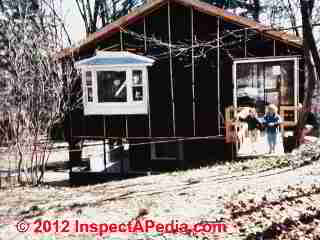
The old standby, asphalt felt (photo at left, construction in 1978), has a perm rating of around 5 and moderately good water resistance, making it suitable for use as a sheathing wrap. However, unlike plastic housewraps, asphalt felt will absorb water when wet.
Once wet, its permeability jumps from around 5 to as high as 60. In the event of water leaking into the wall, asphalt felt may help store some of the water, and its high permeability when wet will promote drying to the exterior. Housewrap, in contrast, tends to trap any liquid water that gets behind it.
Some contractors find felt easier to install and weave into flashings because of its rigidity and narrow roll width. Felt, however, tends to get brittle and deteriorate under long-term exposure to UV radiation and is more prone to tear during installation than plastic housewraps.
For situations where prolonged exposure is expected, plastic house- wraps are better suited. Otherwise, asphalt building felt remains a valid choice for modern homes.
Although traditional 15-pound rag felt weighed 15 pounds per 100 square feet, the material sold today as No. 15 felt is made of recycled cardboard and sawdust and actually weighs only 7 to 8 pounds per square.
Most of the lightweight building paper sold has no ASTM rating. ASTM-rated No. 15 felt is either a minimum of 7.6 pounds per square (ASTM D4689) or 11.5 pounds per square (ASTM D226). Similarly, the unrated variety of No. 30 felt typically weighs only 15 to 20 pounds per square versus 26 to 27 pounds for rated Type 2 felt (ASTM D226).
Grade D Building Paper Used for Housewrap
Grade D building paper is an asphalt-impregnated kraft-type paper, similar to the backing on fiberglass insulation. Unlike asphalt felt, it is made from new wood pulp, rather than recycled material.
Its most common use is under stucco in the western United States. The vapor permeance of Grade D paper is similar to asphalt felt. Its liquid water resistance ratings range from 20 to 60 minutes, as measured by using the boat test (see “Water Resistance,” previous page).
Because Grade D paper tends to deteriorate under prolonged wetting, the trend in three-coat stucco is to use two layers of 30-minute paper. Because the paper tends to wrinkle, the two layers tend to form a small air space, creating a rain-screen effect.
Plastic Housewrap Products
There are a wide range of plastic housewraps on the market. Most are non woven fabrics made from either polyethylene or polypropylene. Some have perforations to let water vapor pass through and the others are designed to let water vapor diffuse through the fabric itself. Because there is no single testing standard for plastic housewrap performance, it is difficult to make apples-to-apples comparisons. However, published performance data and limited field studies suggest the following:
- Permeance to water vapor. The leading nonperforated products (Tyvek®, R-Wrap®, and Amowrap®) are significantly more permeable to water vapor, ranging from 48 to 59 perms, than nearly all the perforated materials.
- Water resistance. All sheathing wraps adequately shed water on vertical surfaces. Pooled water, however, will leak through most perforated plastic housewraps over time, while the nonperforated materials will contain liquid water indefinitely. No. 15 asphalt felt retains water moderately well, but it allows some penetration over time.
- Damage from extractives. Some researchers have noted that extractives leaching out of redwood and cedar siding can cause plastic housewrap to lose its water repellency and to deteriorate. Back-priming the wood siding or leaving an air space behind the siding will help prevent this. Stucco will also degrade plastic housewrap and is rarely installed over it.
- Recommendations. Given their high permeance ratings and excellent resistance to liquid water, the nonperforated housewraps are a good choice for most building applications. Traditional asphalt felt is also a good option. Many contractors find plastic sheathing wraps more convenient than asphalt felt in that they weigh only 1 to 2 pounds per square, and they are more flexible in the cold and more tear-resistant. Also they are available in 9- to 10-foot-wide rolls versus 3-foot rolls for asphalt felt.
Draining Housewraps
In the last few years, manufacturers have responded to the need for an air space and drainage plane with a variety of housewrap products that are either wrinkled or corrugated to provide an integrated air space. These include products intended primarily for stucco, such as DuPont’s StuccoWrap®, and others developed for siding, such as Raindrop Housewrap, which is a plastic drainage mat from Pactiv, Inc. (see “Resources,” page 47 of Best Practices Guide to Residential Construction (Steve Bliss, J Wiley & Sons) ).
The air space created by these products is minimal, ranging from 0.02 inch thick for StuccoWrap to 0.008 for RainDrop®. Although these materials may allow for some drainage, it is unlikely that they will provide any measurable airflow to promote drying.
A more promising approach is a 1/4-inch nylon matrix, called HomeSlicker®, which has vertical drainage channels and installs between the sheathing wrap and siding. The material is rigid and thick enough to resist compression by the siding but thin enough that windows, doors, and trim can be installed without furring.
- - Adapted with permission from Best Practices Guide to Residential Construction (Steve Bliss, J Wiley & Sons) .
Sizing up Vinyl Siding - The Requirement for a Moisture Barrier Beneath Vinyl Siding - When Can the Vapor Barrier be Omitted?
This discussion is now found at VAPOR BARRIERS, VINYL SIDING
...
Reader Comments, Questions & Answers About The Article Above
Below you will find questions and answers previously posted on this page at its page bottom reader comment box.
Reader Q&A - also see RECOMMENDED ARTICLES & FAQs
Comment:
(May 31, 2011) DIMA said:
Very clever
Question: asphalt roofing paper atop Tyvek?
(Aug 26, 2012) ray said:
can asphat building paper be applyed over top of tyvek plastic wrap
Reply:
Can, yes. But why?
Question: siding and wall leak diagnosis needed
(Feb 15, 2014) andy said:
The wind is blowing rain through my out side wall to inside wall
Reply:
Andy, you'll need to inspect very carefully the head flashing at windows and doors, starting with the J-channel if your home has vinyl or aluminum siding installed. Then you may have to pull off some siding when weather permits to see where water is entering - most likely there are flashing or housewrap errors.
Sometimes we can't see exactly where water is entering until we remove some of the siding from suspicious areas.
Question: using Typar under steel siding on a barn
(Feb 16, 2014) Ruth said:
i am wondering about using Typar under steel siding on a barn. Is it studs then Typar then strapping then steel siding or is it studs then strapping then Typar then the siding on it? I can see reasons for doing each way. Went through the Typar site and do not see this info...nor a contact address. Thanks!
Reply:
Ruth; starting by admitting I don't know, I still have an opinion: in normal wood frame construction the housewrap is installed on the exterior surface of the wall sheathing that has been nailed over studs - then we use flashing tape around windows and doors, then the siding is installed, then trim.
I take it that by strapping you refer to diagonal steel straps for wall rigidity since there is no sheathing being installed? If we were installing sheathing we'd do that, then install the house wrap, then the siding. If there is no sheathing, just strapping, it'd probably be best to install the housewrap after the strapping - my OPINION - is that by doing so we avoid damaging or ripping the siding or punching unnecessary holes in it while installing strapping.
But as housewrap is normally stapled to wood sheathing, how are you fastening it to the structure? Tape?
So my final arm-waving is to suggest that you ask the building and siding manufacturer for advice. Depending on the type of exterior steel siding being installed, there may be no advantage at all to using any building wrap product.
(Feb 16, 2014) Ruth said:
hi - thanks for your comments - correct - no sheathing will be used. By strapping I mean wood strips put on the framing members...if using wood siding we would put the Typar on the 2x6 framing material and then put the strapping on which creates an airspace and then the wood siding. But as this is steel siding we are not sure if an airspace is needed. The strapping is used to have something to fasten to as the siding will be installed vertically.
We have two opinions if the siding is directly against the Typar....one is the screws (steel siding is installed with screws/washers could mess up the Typar as it goes through it into the strapping (I think this was from experience)...and the other view is the idea that the Typar would protect the wood strapping from water damage.
I think the siding company had no opinion...cannot find a Typar contact number or email but will ask retailer.
Reply:
Ruth you make some good points; If you put the housewrap on before the horizontal strapping (to which vertical siding will be fastened), followed by strapping, then siding, not only does the strapping protect against a possible (IMO unlikely) event of a screw binding and tearing the housewrap, you also obtain a (probably 3/4") air gap that may improve the wall energy performance and would certainly allow for condensate or water penetration down to the wall bottom.
I'm doubtful that the retailer will have more than an arm waving opinion (as ours) about this, but people who build steel buildings should have an opinion.
Here are a couple of interesting references
(While I don't always agree with him, Joe L. in my first citations is indeed an industry expert whose views should be considered)
- Lstiburek, Joseph. "Water-Managed Wall Systems." Journal of Light Construction (2003).
- Lstiburek, Joseph. "Moisture control for buildings." ASHRAE journal 44.2 (2002): 36-41.
- Kasal, Bo, and Pat Huelman. "Design of Residential Building Shells: Minneapolis and Atlanta." (2004).
- Carll, Charles. "Rainwater intrusion in light-frame building walls." Proceedings of the second annual conference on durability and disaster mitigation in wood-frame housing. Madison, WI: Forest Products Society. 2000.
- Charlson, Joseph A. "Composite insulated framing members and envelope extension system for buildings." U.S. Patent 6,125,608, issued October 3, 2000.
- Zatkulak, Tony D. "Method for reducing penetration of liquid through nonwoven film-fibril sheets pierced by fastening elements." U.S. Patent 5,497,596, issued March 12, 1996.
Question:
(May 4, 2014) fj said:
when do I install typar housewrap between osb sheathing and 1 inch rigid board insulation or after osb and rigid board insulation THANK-YOU
Reply:
FJ:
If you're using housewrap as recommended it's the outer-most covering before the final siding is installed.
Question: Use Typar or house wrap on a 30 year old cedar sided house before installing vinyl siding?
Dec 15, 2014) Anonymous said:
should installers use typar or other new house wrap on a 30 year old cedar sided house before installing vinyl siding
Reply:
Unclear; are you removing the old siding or leaving it in place? What's beneath the old siding and in what condition is it?
Question: condensation and frost or ice on interior side of house wrap
Richard said:
Part of our basement is below grade with concrete walls and part above with traditional framing, Tyvek wrap, and siding. In cold weather, the inside of the Tyvek behind the insulation on the framed walls is wet, sometime ice, even with the house humidifier turned off. Is this normal? Should I be concerned? Thank you,
Richard
Reply:
Richard
Certainly I'd want to know why you're getting condensation in an area that ultimately could be asking for a mold or insect damage problem. Look for missing insulation, air leaks, or leaks from outside (less likely from what you've described).
Question: information about Insultex® house wrap
(Mar 17, 2015) David Osina said:
Have you examined the house wrap "Insultex"?
Reply:
No. I can tell you this is an insulating house-wrap that can add R-3 (1.0 mm thickness) or R-6 (1.5mm thickness) insulation value to the house wall (according to the company). Whether or not you want to add insulation to the exterior of your wall sheathing may depend on the climate where you live. Here is contact information from the company who can provide more details.
- Innovative Designs, Inc. 124 Cherry St. Pittsburgh, PA, 15223 P: 412-799-0350 F: 412-782-5303
More Information about Insultex® house wrap is at the company's website: http://www.insultexhousewrap.com/ from which we excerpt:
Insultex House Wrap ® is a closed-cell foam composite with superior drainage and R-Value. This certified product meets or exceeds the competition in air and water resistance moisture vapor permeability and durability.
Watch out: website: insultex.com was not working other than as an advertising page as of October 2015
Question: installing new siding over asbestos-cement siding
(Sept 7, 2015) Marc G. said:
Can insulated siding go over asbestos siding without housewrap?
Please advise.
thanks!
Reply:
Physically "can" - of course.
Should ? The risk of omitting the housewrap is that there may be future leaks into the wall structure and wall cavity. You'd think "not" considering that you're adding a layer of siding, but in fact every nail banged through furring strips or banged directly into the asbestos cement siding is going to both punch holes and often physically break or crack much of the material.
We don't know the condition of any water or vapor barrier behind the asbestos cement siding but typically what was used was red rosin paper or at best 15# roofing felt.
In sum your job will be more water resistant if you use a housewrap.
...
Continue reading at VAPOR CONDENSATION & BUILDING SHEATHING or select a topic from the closely-related articles below, or see the complete ARTICLE INDEX.
Or see these
Recommended Articles
- AIR LEAK MINIMIZATION
- BASEMENT CEILING VAPOR BARRIER
- CRAWL SPACE VAPOR BARRIER LOCATION
- FELT 15# ROOFING, as HOUSEWRAP/VAPOR BARRIER
- HOUSEWRAP AIR & VAPOR BARRIERS
- HOUSEWRAP INSTALLATION
- HOUSEWRAP PRODUCT CHOICES
- HOUSEWRAP at SILLS, SOLES, TOP PLATES
- INDOOR AIR QUALITY & HOUSE TIGHTNESS
- MOISTURE in BUILDING WALLS, EFFECTS
- MOISTURE CONTROL in BUILDINGS
- PERM RATINGS of BUILDING MATERIALS
- PLASTIC MOISTURE BARRIER FLAME SPREAD
- RAIN SCREEN PRINCIPLES
- STUCCO WALL WEEP SCREED DRAINAGE
- VAPOR BARRIERS & AIR SEALING at BAND JOISTS
- VAPOR BARRIERS & CONDENSATION
- VAPOR BARRIERS & HOUSEWRAP
- VAPOR BARRIERS, VINYL SIDING
- VAPOR CONDENSATION & BUILDING SHEATHING.
Suggested citation for this web page
VAPOR BARRIERS & HOUSEWRAP at InspectApedia.com - online encyclopedia of building & environmental inspection, testing, diagnosis, repair, & problem prevention advice.
Or see this
INDEX to RELATED ARTICLES: ARTICLE INDEX to EXTERIORS of BUILDINGS
Or use the SEARCH BOX found below to Ask a Question or Search InspectApedia
Ask a Question or Search InspectApedia
Try the search box just below, or if you prefer, post a question or comment in the Comments box below and we will respond promptly.
Search the InspectApedia website
Note: appearance of your Comment below may be delayed: if your comment contains an image, photograph, web link, or text that looks to the software as if it might be a web link, your posting will appear after it has been approved by a moderator. Apologies for the delay.
Only one image can be added per comment but you can post as many comments, and therefore images, as you like.
You will not receive a notification when a response to your question has been posted.
Please bookmark this page to make it easy for you to check back for our response.
IF above you see "Comment Form is loading comments..." then COMMENT BOX - countable.ca / bawkbox.com IS NOT WORKING.
In any case you are welcome to send an email directly to us at InspectApedia.com at editor@inspectApedia.com
We'll reply to you directly. Please help us help you by noting, in your email, the URL of the InspectApedia page where you wanted to comment.
Citations & References
In addition to any citations in the article above, a full list is available on request.
- Steve Bliss's Building Advisor at buildingadvisor.com helps homeowners & contractors plan & complete successful building & remodeling projects: buying land, site work, building design, cost estimating, materials & components, & project management through complete construction. Email: info@buildingadvisor.com
Steven Bliss served as editorial director and co-publisher of The Journal of Light Construction for 16 years and previously as building technology editor for Progressive Builder and Solar Age magazines. He worked in the building trades as a carpenter and design/build contractor for more than ten years and holds a masters degree from the Harvard Graduate School of Education. Excerpts from his recent book, Best Practices Guide to Residential Construction, Wiley (November 18, 2005) ISBN-10: 0471648361, ISBN-13: 978-0471648369, appear throughout this website, with permission and courtesy of Wiley & Sons. Best Practices Guide is available from the publisher, J. Wiley & Sons, and also at Amazon.com - Butt, Thomas K., FAIA, “Water Resistance and Vapor Permeance of Weather Resistive Barriers,” Journal of ASTM International, November/December 2005, Vol. 2, No. 10,www.intres.com/about/pub/WeatherBarriers.pdf, November 2005.
- Ahuja, Deepak, B. Matthew Smith, and M. Arch. "Potential Pitfalls of a Green Building Material: A Case Study of Cellulose Insulation." In Forensic Engineering 2012@ sGateway to a Safer Tomorrow, pp. 239-249. ASCE, 2013.
- Gibson, Scott. "Air and Vapor Barriers." Fine Homebuilding 4, no. 94 (1994): 48-53.
- Hazleden, Donald G., and Paul I. Morris, Ph.D., “The Influence of Design on Drying of WoodFrame Walls Under Controlled Conditions,” in Proceedings: Performance of Exterior Envelopes of Whole Buildings VIII, Integration of Building Envelopes, Clearwater Beach, Florida, December 2-7, 2001.
- International Building Code (2006),
- "Leaky Housewraps", Paul Fisette, Building Materials and Wood Technology, web-search 4/17/2008 - 2010, original source: http://www.umass.edu/bmatwt/publications/articles/leaky_housewraps.html -
This page is maintained by the Building and Construction Technology program in the Department of Environmental Conservation, University of Massachusetts Amherst. David Damery, Program Director, Room 118, Holdsworth Natural Resources Center, University of Massachusetts, Amherst, MA 01003, Tel: +1 (413) 545-1770, email: ddamery@nrc.umass.edu - Kaellner, Bradford R., "Attachment# 14 Impact Of Title 24 Residential Leakage Reduction Credit On Water-resistive Barriers In California Homes", Architectural Energy Corporation, Boulder CO, USA, for California Energy Commission, Public Interest Energy Research Program, (2006).
- Listiburek, Joseph W., "Chubby CHecker and the "Fat Man" Do Permeance", ASHRAE Journal, June 2015 pp. 58-64
- “Weather-Resistive Barriers: How to select and install housewrap and other types of weatherresistive barriers,” U.S. Department of Energy, www.eere.energy.gov/buildings/info/documents/pdfs/28600.pdf, October 2000.
- Weston, Theresa A., Ph.D., and Xuaco Pascual, “The Function and Performance of WeatherResistive Barriers During Building Construction,” Performance of Exterior Envelope of Whole Buildings IX International Conference, December 5-10, 2004.
- Weston, Theresa A., Ph.D., Michel Stachnik, Ph.D., James Waggoner, “Development of a Textured Spun-Bonded Polyolefin Water Barrier for Stucco and EIFS,” ASHRAE Transactions 2001, V. 107, Pt. 1, 2001.
- Our recommended books about building & mechanical systems design, inspection, problem diagnosis, and repair, and about indoor environment and IAQ testing, diagnosis, and cleanup are at the InspectAPedia Bookstore. Also see our Book Reviews - InspectAPedia.
- Best Practices Guide to Residential Construction, by Steven Bliss. John Wiley & Sons, 2006. ISBN-10: 0471648361, ISBN-13: 978-0471648369, Hardcover: 320 pages, available from Amazon.com and also Wiley.com. See our book review of this publication.
- Decks and Porches, the JLC Guide to, Best Practices for Outdoor Spaces, Steve Bliss (Editor), The Journal of Light Construction, Williston VT, 2010 ISBN 10: 1-928580-42-4, ISBN 13: 978-1-928580-42-3, available from Amazon.com
- WEATHER RESISTIVE BARRIERS [PDF] U.S. Department of Energy, ", how to select and install housewrap and other types of weather resistive barriers
- In addition to citations & references found in this article, see the research citations given at the end of the related articles found at our suggested
CONTINUE READING or RECOMMENDED ARTICLES.
- Carson, Dunlop & Associates Ltd., 120 Carlton Street Suite 407, Toronto ON M5A 4K2. Tel: (416) 964-9415 1-800-268-7070 Email: info@carsondunlop.com. Alan Carson is a past president of ASHI, the American Society of Home Inspectors.
Thanks to Alan Carson and Bob Dunlop, for permission for InspectAPedia to use text excerpts from The HOME REFERENCE BOOK - the Encyclopedia of Homes and to use illustrations from The ILLUSTRATED HOME .
Carson Dunlop Associates provides extensive home inspection education and report writing material. In gratitude we provide links to tsome Carson Dunlop Associates products and services.


